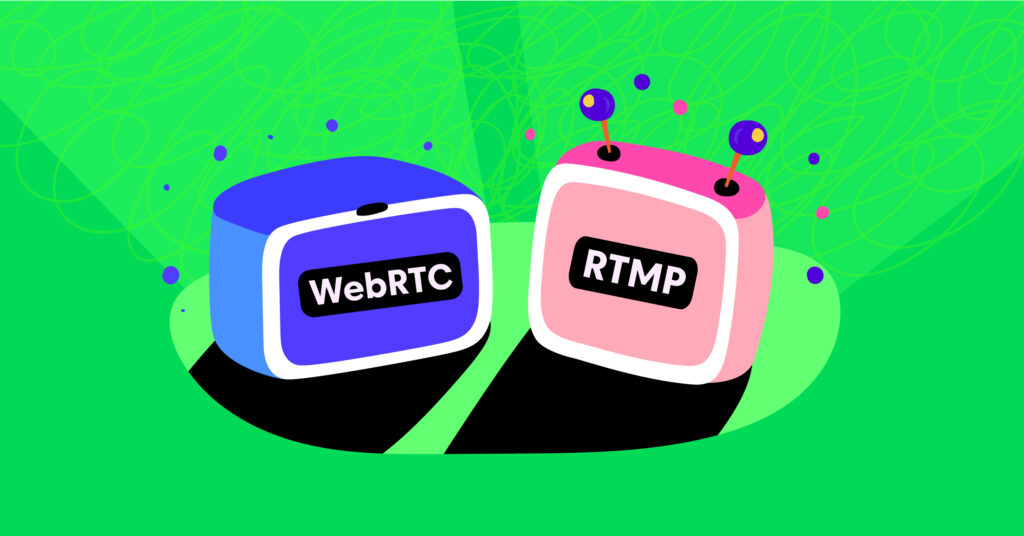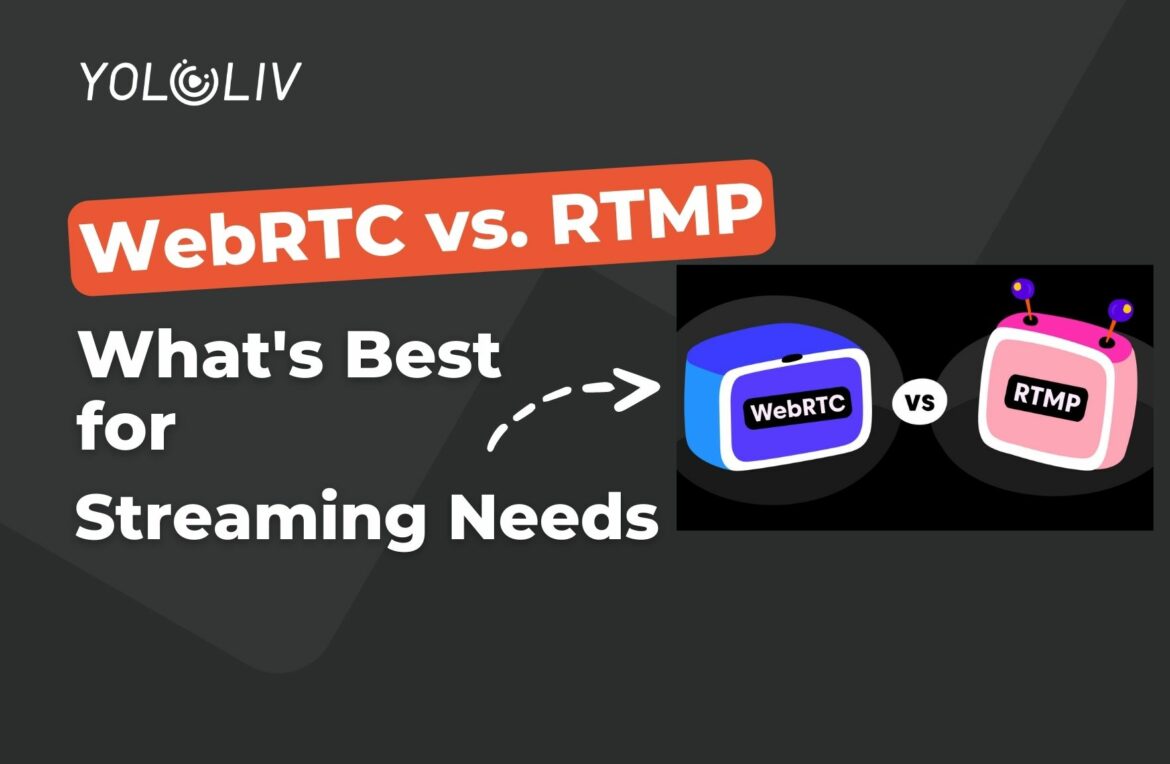Are you facing challenges in selecting the appropriate video streaming protocol for your business? Two widely used protocols, RTMP and WebRTC, possess distinct advantages and disadvantages.
In this article, we will extensively examine both protocols, conducting a thorough comparison based on aspects such as latency, compatibility, bandwidth, and more. We will also delve into their methods of incorporating audio and explore popular video streaming protocols currently accessible in the market. Furthermore, we will analyze how WebRTC measures up against other established standards in the industry and suggest strategies for enhancing your WebRTC infrastructure.
By the conclusion of this post, you will possess a clear comprehension of the protocol that best aligns with your specific streaming requirements.

WebRTC vs. RTMP: Which Protocol is Best for Streaming?
When it comes to streaming videos, the decision between RTMP and WebRTC is of utmost importance. Both protocols offer unique benefits and cater to different demands. Let’s explore the details of WebRTC vs. RTMP to determine the most suitable protocol for video streaming.
RTMP Explained
RTMP, known as Real-Time Messaging Protocol, is a widely supported streaming protocol developed by Adobe. It has enjoyed popularity for many years, particularly due to its compatibility with Adobe Flash Player. RTMP ensures secure and reliable data transmission to stream video and audio. It incorporates adaptive bitrate streaming, guaranteeing smooth playback even when network conditions are unstable. It’s worth noting that RTMP is a proprietary protocol, and its usage has decreased recently with the phasing out of Flash Player.
WebRTC Explained

WebRTC, a highly advanced protocol backed by the Internet Engineering Task Force (IETF) and adopted by modern web browsers, is the opposite. Due to its superior suitability for real-time communication, it excels in applications such as online gaming, live video streaming, and video conferencing. WebRTC employs the User Datagram Protocol (UDP) to provide a constant flow of video and audio data with minimum latency. Furthermore, it supports dynamic adaptive streaming, delivering high-quality video content while adjusting to varying network conditions.
While RTMP is ideal for older systems and dedicated streaming servers, WebRTC is more suitable for peer-to-peer connections and streaming setups based on web browsers. Its native support in most browsers and the ability to transfer audio and video directly between devices without plugins or additional software makes it a convenient option. Additionally, WebRTC is very helpful for applications like video chat and live video streaming because of its low latency and real-time video and audio communication capabilities.
To sum up, the choice between RTMP and WebRTC depends on the specific requirements of your streaming platform. If you need compatibility with older systems and widely supported streaming servers, RTMP might be the appropriate protocol. However, if low latency, real-time communication, and seamless integration with web browsers and mobile devices are your priorities, WebRTC is the recommended protocol. Assess your needs and carefully consider the advantages of each protocol to make an informed decision for delivering top-quality video content to your audience.
Understanding Video Streaming Protocols
To grasp the distinction between RTMP and WebRTC, it’s crucial that you first understand video streaming protocols. These include popular options like HLS and MPEG-DASH or less well-known ones such as RTPS or SRT. Choosing which protocol to use will depend on your individual requirements for your stream, from its intended audience size to device compatibility and bitrate demands.
While RTMP is more established and reliable than WebRTC for live streaming media, server-side operations, and plugins such as Adobe Flash Player are required. Alternatively, WebRTC offers faster, more efficient live video streaming with low-latency playback directly in HTML5 browsers, though older browsers may experience compatibility issues.
RTMP (Real-Time Messaging Protocol) Explained
One commonly utilized protocol for live video streaming with a media server is the Real-time Messaging Protocol (RTMP). It has gained significant popularity and is known for its reliability, surpassing WebRTC in terms of reliability. However, RTMP exhibits a drawback in the form of increased latency. Nonetheless, it offers improved live streaming quality and reduced latency compared to WebRTC.
When deciding which protocol to adopt, several considerations come into play, including the number of viewers, compatibility with devices, and the desired stream quality. It would be beneficial to conduct tests with both protocols to arrive at an informed choice. Additional factors that can impact the decision-making process include internet connectivity, browser compatibility, and the availability of bandwidth.

Web Real-Time Communication (WebRTC) Explained
WebRTC is a cutting-edge communication technology protocol that permits the direct and immediate transmission of audio and video content between peers without the use of additional plugins or software. This cutting-edge protocol, supported by reputable companies like Mozilla and Opera, alongside Google, facilitates secure data transfer with encryption and minimal delays.
Through the utilization of this technology based on application programming interfaces (APIs), you can conveniently access videos on different websites that employ WebRTC for live streaming, video conferencing, and diverse applications. With WebRTC’s compatibility across all major web browsers, you can enjoy high-quality streaming without the requirement of specific players or software. Moreover, its low-latency capability ensures a fluid user experience regardless of geographical location.
Comparing RTMP and WebRTC
The comparison between RTMP and WebRTC is an ongoing subject of discussion when it comes to deciding on a suitable video streaming protocol. The choice between them relies on your particular streaming needs, as they each have their own advantages and disadvantages. When aiming to broadcast live events to a wide viewership, RTMP can be the preferred option due to its ability to deliver high-quality results with minimal latency.
On the other hand, if you require immediate and real-time video communication for smaller groups, opting for WebRTC is advisable. It is also important to consider the compatibility of the protocol with available resources like browsers or servers, as this factor can significantly impact its appropriateness. Thus, it is crucial to make a wise selection based on your specific requirements.
How do RTMP and WebRTC Handle Latency?
The decision between RTMP and WebRTC for streaming depends on individual requirements. WebRTC has lower latency and real-time communication capabilities compared to RTMP, an established technology that many platforms still support. It’s important to consider device compatibility, network stability, and security when choosing between the two.
Compatibility and Bandwidth Considerations for RTMP vs WebRTC
When discussing the world of live video streaming, you may have come across comparisons between RTMP and WebRTC. RTMP has been around for a while, whereas WebRTC is a newer protocol that is swiftly gaining recognition due to its minimal latency and exceptional abilities for real-time communication. When faced with the decision of selecting either protocol, it is crucial to consider various factors such as your particular streaming necessities, technical expertise, device compatibility, network stability, and security requirements.
For live video streaming, choosing between RTMP and WebRTC depends on your specific needs. While RTMP offers low latency and high-quality live streaming with widespread support from video players and platforms such as Adobe Flash Player and YouTube, it requires a streaming server.
Comparatively, WebRTC offers an easy setup without the need for a server but may have slightly higher latency. Its open-source project structure, which offers browser-based real-time communication (RTC), including VOIP
and video conferencing, is helping it gain popularity. The choice between the two should be based on factors like device compatibility, network stability, security, bitrate, and bandwidth, along with support for HLS playback in HTML5 web browsers or adaptive bitrate transcoding via MPEG-DASH or HTTP Live Streaming (HLS) protocols.
While RTMP surpasses WebRTC in terms of streaming quality and reduced latency, it necessitates the use of a media server. Conversely, WebRTC does not require a media server and is especially suited for real-time communication, making the setup process more straightforward. In conclusion, your ultimate choice between RTMP and WebRTC hinges upon your specific requirements.
Using UDP vs TCP for Live Video Streaming
There are two main protocols to think about while streaming videos in real-time: UDP and TCP. Although each protocol has its advantages and disadvantages, the decision ultimately relies on the specific requirements of your streaming application.
UDP is a faster protocol that suits live video streaming well because it prioritizes speed over reliability. It doesn’t ensure the delivery of every packet, which means that a few packets might be lost or discarded during transmission. However, in live video streams, this loss is usually unnoticeable as new data quickly replaces any lost packets.
On the other hand, TCP is a slower but more reliable protocol that guarantees the delivery of packets. This makes it suitable for applications where reliability is crucial, like file transfers or video-on-demand services. However, TCP can introduce latency and buffering problems in live video streams due to its reliance on resending lost packets.
Ultimately, the selection between UDP and TCP for live video streaming hinges on the specific requirements of your application. If speed is more important than reliability and you can tolerate some packet loss, then UDP might be the preferable option. If reliability is paramount and you are willing to accept some latency and buffering issues, then TCP might be the suitable choice.
Implementing Low-Latency Streaming with RTMP or WebRTC
When it comes to incorporating fast streaming with WebRTC vs RTMP, there are different considerations to take into account. While RTMP is more appropriate for live streaming and enjoys broader compatibility with video players, WebRTC performs effectively for immediate interaction, offers reduced latency, and provides enhanced security.
Nevertheless, RTMP requires a media server, which can present difficulties during setup, unlike WebRTC, which is simpler to configure and does not rely on a media server. Ultimately, the choice between RTMP and WebRTC will hinge upon your specific streaming requirements and technical expertise.
Integrating Audio with RTMP and WebRTC Streaming
Incorporating audio into your live video stream can be achieved through two different protocols: RTMP and WebRTC. While RTMP is a well-established protocol, WebRTC provides real-time communication capabilities without the requirement of additional software or installations. Nevertheless, both protocols have their advantages and limitations when it comes to merging audio with streaming.
It is crucial to consider aspects like network bandwidth, device compatibility, and audience size when determining which protocol to utilise for your streaming requirements. Since minimizing latency is crucial for live streams, both protocols offer adaptive bitrate streaming technology to optimize the usage of bandwidth. Whether you intend to transmit high-quality video data through browsers compatible with HTML5 or via Adobe Flash Player plugins, your choice between RTMP and WebRTC will be based on your specific needs.
Common Streaming Protocols
Different streaming protocols serve unique purposes for video and audio content, each having its strengths and limitations. In this regard, streaming live video online using the broadly used RTMP requires a dedicated media server. The open-source WebRTC project, on the other hand, enables real-time communication without the need for extra downloads or plugins in browsers and mobile apps. This makes WebRTC particularly suitable for interactive content like video conferencing, where low latency is crucial.
When deciding between WebRTC vs RTMP, factors such as bandwidth, device compatibility, audience size, and specific use cases like playback options or latency requirements should be taken into account. Additional noteworthy protocols include HTTP Live Streaming (HLS), MPEG-DASH, Transmission Control Protocol (TCP), User Datagram Protocol (UDP), and other video streaming protocols.
RTMP (Real-Time Messaging Protocol)
Video, audio, and data may all be transmitted over the internet thanks to the streaming protocol RTMP, which was created by Adobe. It facilitates the delivery of live streams and pre-recorded content. Although it performs admirably in situations requiring minimal latency, it might experience issues when confronted with network congestion or heavy usage. Streaming platforms utilizing RTMP require the utilization of a media server, potentially resulting in increased expenses.
Real-Time Streaming Protocol (RTSP)
The Real-Time Streaming Protocol (RTSP) is a reliable protocol designed to manage video and audio streams of superior quality. It finds frequent application in IP cameras and surveillance systems. Nonetheless, certain devices may experience latency when using RTSP, and a reliable network connection is necessary.
Notwithstanding these limitations, RTSP can serve as a superb option for broadcasting live events or webinars that prioritize top-notch quality. With its proficiency in seamlessly managing high-quality video and audio streams over the internet, RTSP is an ideal choice for individuals seeking uninterrupted transmission of their content to viewers.
Transmission Control Protocol (TCP)
Transmission Control Protocol (TCP) and User Datagram Protocol (UDP) are two streaming protocols that are frequently compared. TCP is the industry standard for reliable data transmission and is commonly used in RTMP streaming, but it may be affected by network congestion or high traffic.
On the other hand, WebRTC uses UDP, which supports real-time and low latency streaming suited for webinars and video conferences. RTPM may be preferred for live events with larger audiences as it offers a more stable connection. It’s crucial to choose the right protocol based on your specific needs and requirements involving low latency streaming or high-quality video playback.
HTTP Live Streaming (HLS)
Delivery of video content over the internet is made possible via HTTP Live Streaming (HLS), an adaptive streaming technology. HLS, an Apple invention, has broad support across numerous platforms and devices, making it a flexible choice for live streaming events with large audiences. The protocol breaks up video content into small chunks and delivers them according to the viewer’s internet connection speed. This ensures that viewers with slower connections can still watch videos without experiencing buffering or low-quality playback. Additionally, HLS is compatible with both RTMP and WebRTC protocols, enabling smooth playback across different browsers and servers.
Dynamic Adaptive Streaming over HTTP (MPEG-DASH)
For smooth video streaming with responsive playback times, Dynamic Adaptive Streaming over HTTP (MPEG-DASH) is an ideal solution. This popular open-source project utilizes HTTP to efficiently deliver media content and supports adaptive bitrate streaming. Streamers benefit from MPEG-DASH’s versatility since it caters comfortably to diverse devices and platforms, including servers using RTMP or WebRTC for synchronization.
In addition to switching between quality levels quickly, it supports live video ingest while ensuring synchronized playback across browsers utilizing HTML5 technology. Choose MPEG-DASH based on your audience size, device compatibility concerns, and particular streaming needs.
Secure Reliable Transport (SRT)
The Secure Reliable Transport (SRT) is a freely available open-source project within the world of video streaming. Its primary objective is to enable the transmission of top-notch video content even when faced with unreliable network conditions. SRT incorporates advanced techniques such as encryption and error correction to guarantee the utmost security and reliability throughout the data transfer process.
User Datagram Protocol (UDP)
User Datagram Protocol (UDP) is the preferred choice for real-time live streaming because of its low latency and fast performance. The protocol collaborates with RTMP or WebRTC protocols to enhance the effectiveness of data transfer and accelerate speeds. UDP is highly suitable for live streaming, gaming, and other activities that demand swift and uninterrupted video transmission.
Due to its capability to swiftly transmit data packets without error correction, UDP has gained popularity among streamers and gamers alike. Hence, if you aim to guarantee a seamless experience for your live video streams, it is advisable to opt for UDP as your primary streaming protocol.
How does WebRTC compare to other Video Streaming Protocols?
In contrast to older methods such as RTMP, WebRTC is a more recent innovation enabling real-time two-way interaction via direct connections between users. It offers reduced latency, superior video resolution, and wider browser compatibility, all without requiring additional external third-party plugins.
WebRTC – An Industry Standard for Low-Latency Audio and Video
When faced with the decision of selecting between WebRTC vs RTMP for online video streaming purposes, WebRTC emerges as the obvious option due to its numerous benefits over RTMP. WebRTC has established itself as the industry standard for low-latency audio and video streaming due to its low latency and excellent video quality. It utilizes a direct connection between users to efficiently handle real-time video data, surpassing the capabilities of RTMP protocol, and it seamlessly supports all major browsers without the need for external third-party plugins.
Furthermore, WebRTC offers improved adaptability and user-friendliness compared to RTPM, making it an optimal option for various applications, including live streaming on popular social media platforms like YouTube or converting email videos.
Improving WebRTC Infrastructure
If you want to improve your WebRTC infrastructure, start by assessing the specific streaming requirements of your project. Afterward, optimize your WebRTC implementation to reduce latency and enhance video quality. An appropriate codec selection coupled with bitrate and bandwidth setting adjustment can help achieve this goal.
Furthermore, the configuration of a low-latency streaming-friendly server and network is also crucial in achieving these results efficiently. Finally, using open-source tools like HTML5 or adaptive bitrate streaming enhances playback compatibility across various browsers.
Pros and Cons of Choosing RTMP vs WebRTC for Your Streaming Needs
It’s important to consider the unique needs of your project and the platforms you intend to employ when choosing between RTMP and WebRTC for your streaming needs. RTMP has been available for a longer time and is supported by most streaming networks. Nevertheless, WebRTC offers high-quality video and audio streams and low-latency real-time communication. Unlike RTMP, which requires a separate server to manage the stream, WebRTC employs peer-to-peer technology that reduces reliance on dedicated servers.
Keep in mind that certain firewalls can block RTMP, whereas WebRTC can pass through them more easily. Compatibility issues can also arise with browsers that require Flash players for playback.
Further Reading on Video Streaming Protocols
When searching for the most suitable video streaming protocol, numerous options are available. Among the widely recognized choices are RTMP and WebRTC streaming protocols. RTMP, having a long history, enjoys extensive compatibility with various streaming platforms. On the other hand, WebRTC is a more recent protocol that offers improved audio and video quality along with minimal latency. It is crucial to carefully evaluate your specific requirements to determine the optimal choice.
Both protocols possess their own merits and drawbacks, so it is advisable to conduct comprehensive research on each one prior to finalizing a decision. Factors such as browser compatibility, server requirements, bandwidth considerations, encryption choices, playback capabilities, transcoding capabilities, support for adaptive bitrate, and others should all be considered. By considering these aspects thoroughly, you can make an educated decision that fulfills all your requirements for live streaming.
Conclusion
Selecting the appropriate streaming protocol holds immense importance in guaranteeing optimal quality and user satisfaction for your viewers. Amidst numerous available options, RTMP and WebRTC emerge as highly favored choices. RTMP, being a long-standing protocol, has gained recognition, whereas WebRTC is currently gaining traction due to its advantageous features like minimal latency and real-time communication abilities.
To make a well-informed decision about the preferred protocol, it is crucial to consider aspects such as compatibility, bandwidth requirements, and latency preferences. Analyze your specific streaming needs and weigh the pros and cons of each protocol carefully. Whether you opt for the reliability of RTMP or the low-latency efficiency of WebRTC, both protocols offer unique advantages that can enhance your video streaming experience.
In conclusion, select the protocol that aligns best with your specific streaming requirements, and take into account factors such as audience size, device compatibility, and the type of content you plan to deliver. By doing so, you can deliver top-quality video content to your audience, ensuring a seamless and satisfying streaming experience.
16,241 total views, 11 views today

Pauline is a Marketing Specialist at YoloLiv, with over three years of experience in overseas digital marketing. She aims to produce high-quality and practical content for all tech lovers and dig deeper into the live streaming fields.


